|
Every fall our office is inundated with calls from clients concerned about
brown foliage on their evergreen trees. They are convinced that the trees are
dying. However, in most cases, there is nothing to be concerned about. What
is happening is commonly called evergreen foliage drop, a natural shedding of
the oldest foliage.
All trees and shrubs renew their foliage annually, producing new leaves in the
spring and shedding the old leaves in the fall. The leaves of deciduous trees,
like maples and oaks, are alive for just one growing season and then fall off
usually in a blaze of color in the autumn. Foliage of evergreen trees lives
from one to several years old, depending on the species. As new growth emerges
in the spring, the older growth becomes shaded and its role in photosynthesis
is diminished. Later in the year this inner or older foliage dies, turns a reddish
brown and is shed, especially in the fall. This is a normal and annual occurrence.
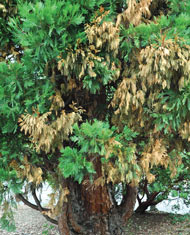 Seiridium Canker disease causing unnatural whole branch dieback.
Seiridium Canker disease causing unnatural whole branch dieback.
In some evergreen species like pines, cedars, arborvitae
and sequoia, this fall browning can take place rather suddenly. Sometimes
this natural occurrence is hardly noticed, but this year it is especially
noticeable, and people are concerned.
The natural foliage drop can be distinguished from disease by its
uniform browning appearing evenly throughout the whole tree. Look around
at other neighboring trees of the same species and you will observe similar
symptoms. The shedding is confined to the innermost or oldest foliage
or needles. The amount of foliage drop depends on the vigor of the tree,
and of the preceding growing season especially in a drought year.
However, there are other serious disease problems that can cause foliage
browning. Diseases cause symptoms and dieback that is a random pattern,
scattered, not uniform in the tree. For example, we are experiencing
a canker disease called Seiridium in incense cedars that causes a scattered
(not uniform) but severe branch and foliage dieback. Large branches and
attached foliage will turn brown and die usually in the lower half of
the tree. Diseased branches should be removed for management of the disease.
So do not be concerned if the new, terminal or current year’s growth
is green and vigorous, the health of the tree is not in jeopardy from
natural foliage drop in evergreens.
The weeping Alaska cedar is a native conifer found growing from Alaska all the way down to Oregon and can achieve heights up to 80’. The Chamaecyparis nootkatensis ‘Pendula’ is a fine variety that forms an outstanding sculptural specimen.
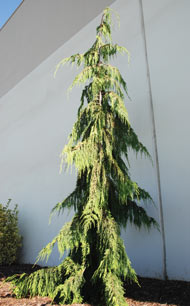
The ‘Pendula’ cultivar is a slender, pyramidal, strongly weeping form that grows slowly to 35’ tall and 12’ wide over its lifespan. It is an excellent specimen tree that features a nodding central leader with graceful pendulant branches that sweep upwards at the end. The rich green foliage hangs like curtains from the branches, creating a graceful accent in the landscape.
The weeping Alaska cedar grows best in full sun and in acidic but well drained moist soil. It is tolerant of poor, heavy clay soils. Weeping cedars are drought tolerant once established in the landscape. This tree is relatively pest free. A valuable characteristic of this species is its high resistance to Phytophthora root rot. This means it can be used to replace other species that have succumbed to this insidious disease.
If you want an even narrower variety, try the ‘Green Arrow’. It grows 30’ tall but only 4’ wide.
|
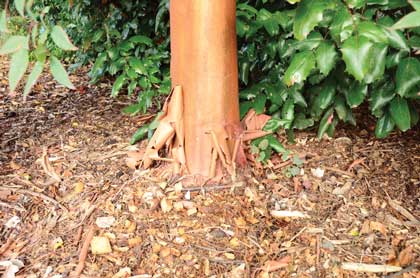
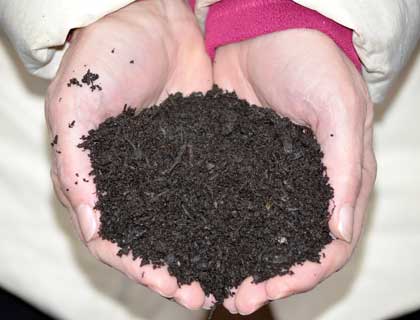 Wood chips (fresh mulch, above) or composted mulch
(below) are both good options for adding nutrients to the
soil feeding your trees and shrubs.
Wood chips (fresh mulch, above) or composted mulch
(below) are both good options for adding nutrients to the
soil feeding your trees and shrubs.
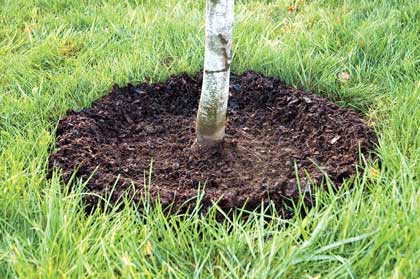 A good tree ring of mulch should look more like a “donut” than a
“volcano”. If possible, get rid of grass in the root zone area.
A good tree ring of mulch should look more like a “donut” than a
“volcano”. If possible, get rid of grass in the root zone area.
“To mulch or not to mulch?” It’s a question that’s
often asked. However, for knowledgeable gardeners mulch is recognized as one
of the most important cultural practices you can do for your plants. Maintaining
your landscape plants in a healthy growing condition is important for your property value as well as the aesthetic benefit. A mulched landscape not only looks good,
but also provides a wonderful environment for root growth. Mulching, coupled
with the Collier Arbor Care Soil
Health Care Program of organic fertilizer and Compost Tea, are the single best things you can do to care for your plants and
your soil — and to keep your yard beautiful.
Benefits of Mulch
- Helps maintain soil moisture. Evaporation is reduced, and the
need for watering can be minimized.
- Helps control weeds. A two to four inch layer
of mulch will reduce the germination and growth of weeds.
- Mulch serves as nature’s insulating blanket. Mulch keeps soils
warmer in the winter and cooler in the summer.
- Many types of mulch can improve soil aeration, structure
(aggregation of soil particles), and drainage over time.
- Composted mulch can improve soil fertility.
- A layer of mulch can inhibit certain plant diseases.
- Mulching around trees helps facilitate maintenance and can reduce the likelihood
of damage from “weed whackers” or the dreaded “lawn mower
blight”.
- Mulch can give planting beds a uniform, well-cared-for look.
While mulching has a cost, its many benefits are well worth the investment.
A mulch application can last for two to three years, but you may want to touch
it up with small amounts each year. You will also be watering and weeding less
and improving your soil at the same time.
Application is Important
Apply a two to four inch thick layer of mulch evenly out to the drip line of
the tree or plant if possible. Leave a few inches of bare ground around the stem
or trunk. Avoid applying mulch “volcanoes” or burying the trunk in
mulch as this will cause the lower trunk to decay. The mulch ring should resemble
a doughnut not a volcano. Once you have mulched, make sure your irrigation water
penetrates and reaches the soil. Any water absorbed by the mulch will help in
retaining soil moisture.
Did you know that trees grow better and have a thicker root system when the root
zone is mulched versus a tree growing in a grassy area? If your tree had a say
in the matter, mulch the entire root zone like a tree in the forest and get rid
of the grass.
What kind of mulch should you use? There are organic and inorganic kinds. Inorganics
include lava rocks, landscape fabrics and river rock, but these are not recommended
for general use. If you choose inorganic mulches and later decide to remove it
or plant into it you will have a big challenge.
Collier Arbor Care recommends organic mulches because of the wonderful benefits
for soil improvement and root growth. There are two major types of organic mulches
in our area: (1) Composted Mulch and (2) Fresh (non-composted) Mulch.
Composted mulch is the most desirable for amending and improving soil, but it
does not suppress weeds well. Compost adds nutrients and promotes a healthy micro-biology
in the soil. If you have a heavy clay soil, till in compost to help break it
up.
Fresh Mulch such as bark or shredded mulch and arborist’s wood chips are
the best for weed suppression. There are many grades of bark mulch from fine
to coarse or made from hemlock or fir, just choose the color and texture you
like the best. The fresh mulches have a minor issue with taking nitrogen from
the soil which can easily be corrected by a small addition of an organic nitrogen
fertilizer.
So which organic mulch should you use? We like using both! Put a half-inch thick
layer of composted mulch down first then use a two to four-inch deep layer of
bark mulch over the top.
Questions about your
soil quality? Call today and let Collier Arbor Care help with a free Soil Health
consultation!
 top » top »
Ecological Landscaping is a method of designing, building, and maintaining
landscapes that considers the ecology of a site and creates a sustainable environment
for the benefit of people, plants, insects and wildlife. Ecological landscaping
strives to balance the building site with the natural environment. The sustainably
built landscape will conserve natural resources, preserve biodiversity, and
protect the environment. With proper design and maintenance, each component
in the landscape; people, plants, water, soil, insects, and wildlife, will begin
to interact together in a sustainable way.
The Five Steps to an Ecological Landscape
1 — Plan the Site
- Evaluate and inventory your site. What kind of soils, sun exposure,
and existing plants do you have?
- Deciduous trees planted on the south side will shade buildings in
the warmer months, but let light and heat through after leaves have dropped
in the fall.
- Use a professional landscape designer to create a plan to fit your
life style as well as providing habitat for wildlife and beneficial insects.
Do you need a lawn to play soccer with the kids or do you like to bird watch?
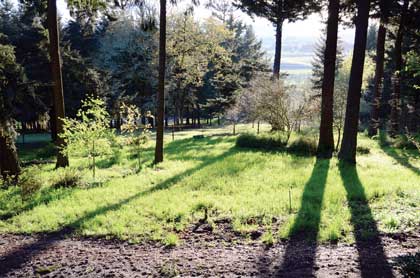 An eco-landscape is one that mimics a natural ecosystem
with a diverse selection of large trees, smaller understory, shrubs, and groundcover.
An eco-landscape is one that mimics a natural ecosystem
with a diverse selection of large trees, smaller understory, shrubs, and groundcover.
2 — Protect Soil
- Conserve the topsoil you have. Don’t remove, compact or destroy.
Never work a wet soil because it destroys soil structure. Healthy soil equals
healthy plants.
- Add compost to improve heavy clay soils, and enhance soil biology.
- Have your soils tested before starting your project.
- Prevent soil erosion by protecting bare soil with mulch or plants.
3 — Planting Options
- Plant trees and shrubs that is adapted to your soil and climate type.
Use native plants or plants that are adapted to the site conditions.
- Select high quality plants material that has good form and root systems.
- Properly plant, don’t plant to deep. Locate the junction of the
trunk flare and the roots, the trunk flare should be planted several inches
above the existing grade.
- Bio-diversity: Plant a diverse mixture of trees, shrubs and groundcover.
Don’t plant a mono-culture like huge expanses of lawn or just one species
of tree. Mimic a natural ecosystem with a diverse selection of large trees,
smaller understory, shrubs, and groundcover.
4 — Landscape Maintenance
- Apply mulches to conserve moisture, improve soil and prevent weeds.
- Use Integrated Pest Management (IPM) which monitors pest activity
based on the host plant and focuses on prevention and environmentally-safe
strategies (such as our Plant Health Care Program) for treating insects and
diseases.
- Use organic pesticides and fertilizers (Our soil health Program uses
100% organic fertilizers and compost tea to improve soils and provide plant
nutrition).
- Use electric or push lawn mowers to maintain lawns, and leave grass
clippings on the lawn to add organic matter and nutrients to the soil.
5 — Water Usage
- Use water saving irrigation heads, and smart irrigation controllers
with rain sensors to reduce water usage.
- Plant native and drought tolerant plants to reduce water usage.
- Lawns use more water than other plant material; shrink the size of
your lawns.
- Watering slowly and deeply in early morning or evening using no more
than 1-inch of water per week in summer.
- Establish a rain garden, which is a depression planted with native
wetland plants that allows rainwater runoff from surfaces like roofs, and driveways
and encourages water absorption into the ground while filtering out pollutants.
If you have questions about caring for a diverse landscape, please feel free
to call
or send an email.
 top » top »
|











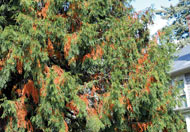 Interior foliage is turning brown—a normal
occurrence.
Interior foliage is turning brown—a normal
occurrence.  Seiridium Canker disease causing unnatural whole branch dieback.
Seiridium Canker disease causing unnatural whole branch dieback.

 top »
top »